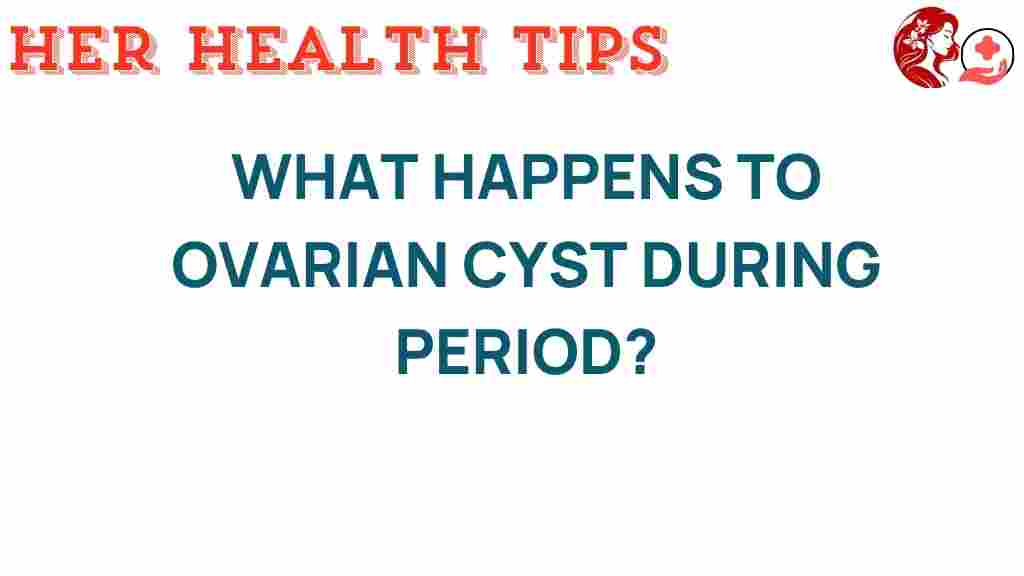The Hidden Truth: What Happens to Ovarian Cysts During Your Period?
Understanding ovarian cysts and their relationship with the menstrual cycle is crucial for women’s health. Many women experience various symptoms associated with their periods, and some may not realize that ovarian cysts can significantly influence these symptoms. In this article, we will explore the intricate connection between ovarian cysts, hormonal changes, and menstrual symptoms. We will also discuss pain management strategies and what to do if you suspect a cyst rupture.
What Are Ovarian Cysts?
Ovarian cysts are fluid-filled sacs that develop on the ovaries. While they are often benign and may resolve on their own, they can sometimes lead to complications. There are different types of ovarian cysts, including:
- Functional cysts: These are the most common type and form during the menstrual cycle.
- Dermoid cysts: These contain tissue like hair and skin.
- Cystadenomas: These develop from ovarian cells and can be filled with a watery or mucous substance.
- Endometriomas: These are associated with endometriosis and can cause significant pain.
The Menstrual Cycle and Hormonal Changes
The menstrual cycle is a complex process regulated by hormones. It typically lasts about 28 days and includes several phases:
- Follicular phase: The body prepares an egg for ovulation. Hormones like FSH (follicle-stimulating hormone) stimulate the growth of follicles in the ovaries.
- Ovulation: Around day 14, a mature egg is released from the ovary.
- Luteal phase: After ovulation, the body produces progesterone to prepare the uterus for potential pregnancy.
During these phases, ovarian cysts can either form or change. Functional cysts, for example, develop in the follicular phase when a follicle doesn’t release an egg.
How Ovarian Cysts Affect Your Menstrual Cycle
Ovarian cysts can impact the menstrual cycle in several ways:
- Irregular periods: Cysts can interfere with hormonal balance, leading to changes in menstrual regularity.
- Heavier or lighter periods: Some women may experience variations in flow due to cysts.
- Increased menstrual symptoms: Pain, bloating, and discomfort can be exacerbated by the presence of ovarian cysts.
Understanding these effects is vital for managing your women’s health effectively.
Recognizing Symptoms Related to Ovarian Cysts
Many women may experience symptoms related to ovarian cysts during their periods. Common symptoms include:
- Pelvic pain: This can range from a dull ache to sharp, severe pain, particularly if a cyst ruptures.
- Bloating: Increased abdominal fullness often accompanies the menstrual cycle.
- Changes in menstrual symptoms: This includes varying flow and duration of periods.
- Pressure symptoms: If cysts grow large, they can cause pressure on the bladder or rectum, leading to frequent urination or difficulty emptying the bowels.
The Impact of Cyst Rupture
A cyst rupture can lead to acute pain and other symptoms. When a cyst bursts, it can release fluid into the pelvic cavity, causing:
- Severe pelvic pain: This pain can be sudden and sharp.
- Internal bleeding: In some cases, a rupture may cause bleeding, which can be serious.
- Signs of infection: Fever, nausea, or vomiting may indicate a complication.
If you experience these symptoms, it’s essential to seek medical attention promptly.
Managing Pain and Symptoms
Effective pain management is crucial for women dealing with ovarian cysts. Here are several strategies to consider:
- Over-the-counter pain relievers: NSAIDs like ibuprofen can help alleviate pain and reduce inflammation.
- Heat therapy: Applying a heating pad to the lower abdomen can provide soothing relief from cramps and discomfort.
- Dietary adjustments: Maintaining a balanced diet rich in fiber can help manage bloating and digestive symptoms.
- Hydration: Drinking plenty of water can help reduce bloating and discomfort.
- Relaxation techniques: Practices like yoga and meditation can help manage stress and improve overall well-being.
Always consult with a healthcare professional before starting any new treatment or if you have concerns about your symptoms.
When to Seek Medical Attention
While many women with ovarian cysts experience mild symptoms, certain situations warrant immediate medical attention:
- If you experience sudden, severe abdominal pain.
- If you have persistent nausea or vomiting.
- If you notice unusual bleeding or discharge.
- If you feel faint or experience rapid heart rate.
These could be signs of complications such as a ruptured cyst or an ovarian torsion, both of which require urgent care.
Understanding Your Reproductive Health
Maintaining good reproductive health involves understanding your body and its functions. Regular check-ups with a healthcare provider can help monitor ovarian health and detect any potential issues early. Here are some tips for maintaining reproductive health:
- Regular gynecological exams: Schedule routine check-ups to discuss any concerns regarding ovarian cysts or other reproductive health issues.
- Tracking your menstrual cycle: Keeping a record of your cycle can help identify irregularities and symptoms that may require further investigation.
- Healthy lifestyle choices: A balanced diet, regular exercise, and avoiding smoking can contribute to better reproductive health.
- Stay informed: Educate yourself about your body, menstrual health, and the implications of hormonal changes.
For more detailed information about reproductive health, you can visit WomensHealth.gov.
Conclusion
Ovarian cysts can significantly affect your menstrual cycle and overall women’s health. Understanding the relationship between these cysts and hormonal changes is essential for managing symptoms effectively. By recognizing the signs of complications like cyst rupture and employing effective pain management strategies, women can take charge of their reproductive health. Always consult with a healthcare professional regarding any concerns or symptoms related to ovarian cysts.
For more information on managing your menstrual symptoms and reproductive health, check out our detailed guide on pain management for women.
This article is in the category Reproductive and created by HerHealthTips Team
